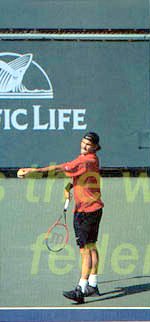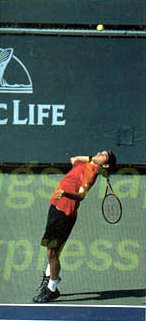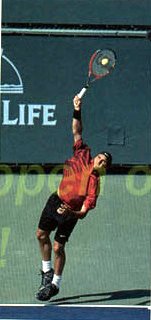 1. When preparing to serve, first visualize the delivery you wish to hit. (Federer already knows which serve he'll use as he steps to the line.) His weight is off the front foot, and he has a slightly open stance for a serve. His front toe is angled to ease his hip and shoulder rotation. But this is more a matter of style, not fundamentals. 1. When preparing to serve, first visualize the delivery you wish to hit. (Federer already knows which serve he'll use as he steps to the line.) His weight is off the front foot, and he has a slightly open stance for a serve. His front toe is angled to ease his hip and shoulder rotation. But this is more a matter of style, not fundamentals. |
 2. Federer keeps his weight on his back foot as his tossing arm goes out to the side of his body, facilitating shoulder and hip rotation. For his serve, it's imperative that he not let the toss get behind his body. Your toss can often determine the success of your serve. Federer's weight begins to move forward as his arms goes up. His racquet and palm are facing downward, which keeps his shoulder muscles relaxed and enables him to achieve a whip-like motion. 2. Federer keeps his weight on his back foot as his tossing arm goes out to the side of his body, facilitating shoulder and hip rotation. For his serve, it's imperative that he not let the toss get behind his body. Your toss can often determine the success of your serve. Federer's weight begins to move forward as his arms goes up. His racquet and palm are facing downward, which keeps his shoulder muscles relaxed and enables him to achieve a whip-like motion. |
 3. This is Federer's power position. His tossing arm is fully extended and his body is prepared to explode into the serve. His shoulders are tilted, and he's leaning forward. Notice, too, how the hitting elbow is in line with his shoulders. This will give Federer excellent throwing action. His flexed knee and hip and shoulder rotation make his serve extremely difficult to read. From this same service position and toss Federer can hit his flat, kick and slice serve to any area of the box. 3. This is Federer's power position. His tossing arm is fully extended and his body is prepared to explode into the serve. His shoulders are tilted, and he's leaning forward. Notice, too, how the hitting elbow is in line with his shoulders. This will give Federer excellent throwing action. His flexed knee and hip and shoulder rotation make his serve extremely difficult to read. From this same service position and toss Federer can hit his flat, kick and slice serve to any area of the box. |
 4. To push off into the serve, Federer has his weight completely on his front leg. As his legs thrust upward, the racquet drops down behind his back with the face perpendicular to the ground and away from his shoulders. This will help him generate power. His non-hitting arm also drops down for the racquet to come through. And Federer's balance is perfect. Recreational players tend to break the sequence at this point by losing their balance. 4. To push off into the serve, Federer has his weight completely on his front leg. As his legs thrust upward, the racquet drops down behind his back with the face perpendicular to the ground and away from his shoulders. This will help him generate power. His non-hitting arm also drops down for the racquet to come through. And Federer's balance is perfect. Recreational players tend to break the sequence at this point by losing their balance. |
 5. Federer makes contact with the ball slightly to his left. Any inconsistency he has with his serve is due to letting the toss drop too far. Here, all his power has propelled him off the ground as he gets full vertical extension into the court. Good extension and natural forearm pronation are both crucial. Federer doesn't pull his head down prematurely, which is another common mistake. His tossing arm tucks in, slowing down his torso, which creates a whipping action at the top of the motion. 5. Federer makes contact with the ball slightly to his left. Any inconsistency he has with his serve is due to letting the toss drop too far. Here, all his power has propelled him off the ground as he gets full vertical extension into the court. Good extension and natural forearm pronation are both crucial. Federer doesn't pull his head down prematurely, which is another common mistake. His tossing arm tucks in, slowing down his torso, which creates a whipping action at the top of the motion. |
 6. After Federer makes contact with the ball, the momentum of his swing carries him into the court. His eyes are looking forward, and his head is up for balance. His hitting arm has fully pronated while his other arm continues the stabilization process. This allows his shoulders to face his opponent head on so he can react quickly for the return. Federer, like all big servers today, lands on his front foot, which lets him either follow the serve to net or get set for a ground stroke. 6. After Federer makes contact with the ball, the momentum of his swing carries him into the court. His eyes are looking forward, and his head is up for balance. His hitting arm has fully pronated while his other arm continues the stabilization process. This allows his shoulders to face his opponent head on so he can react quickly for the return. Federer, like all big servers today, lands on his front foot, which lets him either follow the serve to net or get set for a ground stroke. |
Original Scanned Image as published on Tennis.com
More: Also see Federer's Serve Motion here [flash file].


0 comments:
Post a Comment